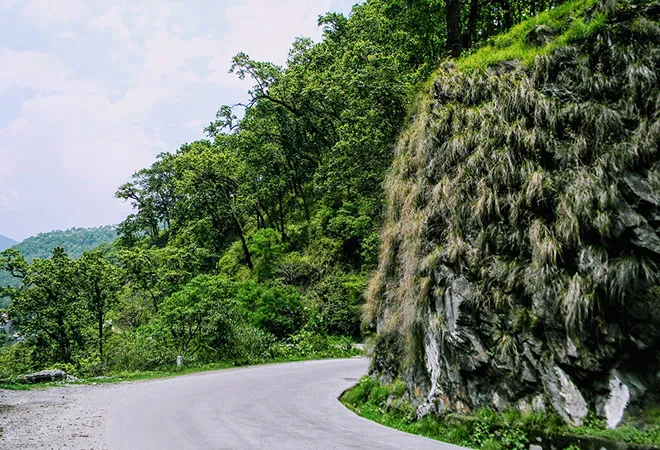-
CENTRES
Progammes & Centres
Location
Our future as a country depends upon the route we take towards growth and, at the same time, how we resolve our environmental challenges.

As India looks to recover from the setbacks caused by the COVID-19 pandemic, the path to a resilient economic recovery requires all stakeholders to realign their priorities and march towards a newer path of economic revival — an inclusive and sustainable one. Instances such as the substantial rise in air pollution in the northern states recently makes it more important for a country like India to ponder upon the need for a path of recovery that maintains the balance between economic recovery and environmental sustainability.
Though some may argue that ‘sustainable growth’ is a utopian dream that is far from reality, two small states in the country are already showing us the way forward. First, it was Sikkim that announced itself as a 100 percent organic state and a plastic free state. Now, the Andaman and Nicobar Islands and the Lakshadweep Islands have been classified by the government as Union territories that generate 100 percent of their electricity from renewable sources. Sikkim, for instance, has been undergoing this paradigm transformation since 1998, much before climate change and sustainable development were trending topics across the world. The journey of Sikkim to become an organic state in order to protect its fragile ecosystem officially began in 2003 and it has come a long way since then, with the state implementing many other environmentally-friendly steps aimed towards conserving water, prohibiting use of single waste plastics, encouragement of usage of eco-friendly packaging and increased health and sanitation facilities. As a result to these steps, Sikkim today stands as an example of an environmentally sustainable growth model, with the Gross State Domestic Product (GSDP) expanding at an CAGR of 15.86% between 2015-16 to 2019-20. The same state is home to 5,000 species of flowering plants, 515 rare orchids, 60 primula species and 36 rhododendron species. In a few more years, with Electric Vehicles becoming prominent, these small states can also take the next leap towards becoming carbon-neutral.
Since 2014, the government of India has also been very proactive in pushing through various green policy measures that have been progressive and impactful. Be it being one of the prime movers of the Paris Agreement to reduce carbon emissions or the ambitious Namami Gange, Jal Shakti and Swachh Bharat Abhiyan initiatives, India has always been on the move with regards to its environmental consciousness. Further, steps taken towards reducing our dependency on fossil fuels have ranged from the government’s special focus towards devising a friendly policy framework for electric mobility and lithium ion battery manufacturing units to metro rail transportation in the country. The Prime Minister’s announcement of increasing India’s renewable energy targets to 450 GW from 175 GW through high quality equity and debt financing is also a big step towards enabling India to become a low carbon economy. The present government’s journey towards climate protection has also been well recognised around the world, with India ranking in the top 10 countries for 2020 in the Climate Change Performance Index (CCPI) rankings, a quantum leap from the 31st rank in 2014.
A better route could be the larger states taking the cue from the smaller states and contextualising a model as per their standing on the ground.
Banking on these structural reforms and the support of the government, investments in a greener economy is growing steadily in the country and the future seems to be better and brighter for India. As per a CRISIL estimate, investment in the space may see a 35 percent growth amounting to INR 1.5 lac crores in the next three years. However, the path to a greener recovery for a country as diverse as India would need much more than these steps, specifically for states with larger populations like Uttar Pradesh, Maharashtra, and Bihar. Issues such as sustaining economic growth, pulling millions out of poverty, bringing electricity to millions who still lack access to it, and generating ample employment opportunities for a predominantly young population are still the issues that the respective State governments need to prioritise before other concerns. Smaller states may lead the way in adopting green practices but the larger ones may, therefore, not be able to exactly replicate it. A better route could be the larger states taking the cue from the smaller states and contextualising a model as per their standing on the ground. However, one commonality among all the states is the necessity to involve stakeholders at every level, from the central and state governments to the local authorities and citizens, to drive the change.
Table 1: Steps by States to promote green practices
| Steps Initiated | States |
| States that initiated steps to ban the use of single-Use Plastics |
1. Sikkim 2. Himachal Pradesh 3. Meghalaya 4. Assam 5. Telangana 6. Uttar Pradesh 7. Maharashtra 8. Tamil Nadu |
| Top States with best Renewable energy Installations in the last 4 years |
1. Karnataka 2. Gujarat 3. Andhra Pradesh 4. Tamil Nadu 5. Rajasthan 6. Telangana 7. Maharashtra 8. Madhya Pradesh 9. Sikkim 10. Uttar Pradesh |
| States with Organic Certification Agencies |
1. Madhya Pradesh 2. Gujarat 3. Telangana 4. Sikkim 5. Bihar 6. Karnataka 7. Odisha 8. Rajasthan 9. Uttarakhand 10. Chhattisgarh 11. Tamil Nadu 12. Uttar Pradesh |
| States with Approved Electric Vehicle Policy |
1. Andhra Pradesh 2. Karnataka 3. Kerala 4. Madhya Pradesh 5. Maharashtra 6. Delhi 7. Tamil Nadu 8. Telangana 9. Uttarakhand 10. Uttar Pradesh |
| State with Dedicated Water Policy | 1. Meghalaya |
Many Indian districts, especially those along the borders and hinterlands, can become carbon neutral and organic relatively easily. Steps such as classifying districts in the country as a 100 percent ‘Green District’ could be one step. An aspirational green district would not generate single use plastic waste, its power requirement would be met only through alternate sources of energy, electric vehicles would be encouraged as the source of mobility, and the district would withdraw only as much water for human activity as it gets from natural precipitation. This will require a combined effort from everyone — from the local administration to the inhabitants of the district — and can only succeed through behavioural change among the people. Many states in the Northeast such as Meghalaya, Arunachal Pradesh and Assam have already been working towards prohibiting single use plastics and encouraging organic farming. Backed by government subsidies and efficient implementation of government schemes, solar and wind power have also been growing rapidly and with dam-less hydroelectric units becoming more viable, the dream of becoming 100 per cent green is not far away for many districts across the country.
Our future as a country depends upon the route we take towards growth and, at the same time, how we resolve our environmental challenges. As per estimates, India as a country would require an average investment of US$ 1 trillion dollars over the next decade to undergo a green transformation. This would require dedicated green funds, investments in infrastructure, state-of-the-art technological interventions and, most importantly, a behavioural change at the core of developmental initiatives which would facilitate this change faster.
The views expressed above belong to the author(s). ORF research and analyses now available on Telegram! Click here to access our curated content — blogs, longforms and interviews.

Rouhin Deb was an Associate Fellow at ORF Kolkata. His research focuses on informal competition strategic choices and international businesses.
Read More +